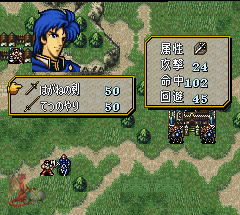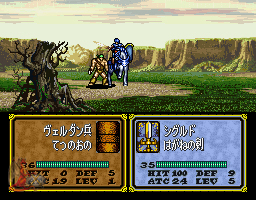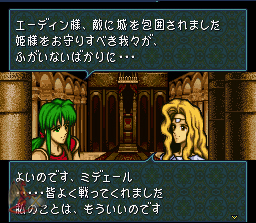|
|

|
PLATFORM
|
SNES
|
BATTLE SYSTEM
|

|
INTERACTION
|

|
ORIGINALITY
|

|
STORY
|

|
MUSIC & SOUND
|

|
VISUALS
|

|
CHALLENGE
|
Very Hard
|
COMPLETION TIME
|
More than 80 Hours
|
|
OVERALL

|
+ Birth of modern Fire Emblem combat...
+ ...that varies from all subsequent entries
- Terrible inventory system
- Enemies get to cheat a bit
|
Click here for scoring definitions
|
|
|
The Fire Emblem series has gone through, at this writing, eleven iterations. Its earliest titles possessed the essence of the series without a great deal of refinement and game mechanics that would be introduced later. Much of this refinement and many of the mechanics were introduced in 1996 with Fire Emblem: Seisen no Keifu, or Genealogy of the Holy War, a game that is recognizably the blueprint later games in the series would use. This game also features a number of elements that have never been seen again, and thus remains unique within the Fire Emblem pantheon. Its Japan-only release makes the story much harder to follow, but the combat is intuitive regardless.
The story herein differs from Fire Emblem norms mainly thanks to the enormous difference in the size of battlefields, and thanks to a startling development midway through. It starts with Sigurd, lord of Grandbell, being drawn into a conflict over the dissemination of numerous holy weapons amongst the various nations. The breakdown in the power balance results in Sigurd and his many friends being called upon to engage the many forces running wild over the continent. What sounds conventional enough (by Fire Emblem standards) is interesting enough even through the linguistic barrier, but the structure is unusual in this game. Midway through a massive time jump of about 20 years occurs, and Sigurd's son Selice takes command with an army comprised mostly of the first half of the game's children.
Combat, in its bare essentials, will be familiar to veterans of later Fire Emblem titles and veterans of tactical RPGs at large. Movement of units takes place on a square-littered battlefield, characters gain experience upon attacking enemies and for every 100 experience points gain a level-up with the prospect of statistic increases. The weapons triangle is introduced in this game to the series, with axes being strong against lances, lances strong against swords, and swords strong against axes. Bows circumvent this triangle but are strong against aerial units. Magic is also present, both for healing and attack purposes. Magic has a triangle of effect that is different from what would exist later in the series, with lightning beating fire, fire beating wind, and wind beating lightning. Light and dark magics do exist but circumvent the triangle. If a player character is brought down in battle, he or she is dead. There is a staff that can revive units, but it may or may not be usable by the character holding it.
Fire Emblem: Seisen no Keifu differs from subsequent titles in the series in numerous ways, however. The most apparent is the sheer size of its battlefields. The prologue chapter is as large as a late-game battle in a more recent Fire Emblem title, and subsequent battles are far larger than in any later title in the series or most other tactical titles. First Sigurd, then Selice must seize enemy-held castles while guarding the castle with which the player begins the chapter. The enormous size of battlefields causes each battle to be structured differently than all later titles, with the total enemy force not visible on the field at the beginning. With just about every castle seizure, previously inaccessible areas open up to movement and additional enemy forces appear. The sheer size of battlefields, plus their ability to move again after taking an action, gives any unit with a mount a great advantage. As a concession to the gargantuan size of the battlefields, the player may save at the beginning of every turn. As another apparent concession to the mammoth battlefield size, every character currently on the player's team can be deployed simultaneously.
 Which weapon works against an axe-wielder... I wonder....
Which weapon works against an axe-wielder... I wonder....
|
|
An element that reappeared in Fire Emblem: the Sacred Stones is that of Skills, which originated in this title. Skills are inherent to characters, though class change sometimes adds skills. Breaking with tradition, attacking in this game twice if the relative speeds permit it can only be done if the character has the necessary Skill of Pursuit. Other Skills include Combine (to attack more than once in succession regardless of the relative speeds), Elite (doubles experience received), Bargain (possessed only by a Thief and causes the enemy's money to wind up in the character's possession), Wrath (makes all attacks critical if the character is low on HP), and Leadership (works akin to the Support system in later Fire Emblem titles save that it affects everyone in range and not just a select few). Ayla has a particularly useful Skill that can be passed down should she have children, the Moonlight Sword that when it activates guarantees five consecutive attacks before the enemy can react.
The transition from Sigurd's force to Selice's midway through the game offers a blatant example of another unique feature to this title, and that is implied in the Genealogy of the title. Players, by keeping certain male and female characters together in the game's first half, can get them to fall in love and have children. The children each woman has are fixed, one male and one female, but the father's influence will be quite palpable. Not only will the children's statistic growth rates be greater in all respects thanks to their parents' affinities, the father will also pass down Skills to his children that may aid immeasureably. Children end up with the Skills possessed by both parents, and this makes father selection important. Should a female character in Sigurd's force not fall in love, or should she be killed, other characters will appear in Selice's part of the story to recruit. I did not see any of these characters thanks to pairing all women successfully, but their growth rates and Skills are fixed and not mutable in the way that the children of the first half are.
Combat is easy to take in here for any Fire Emblem veteran, and the process is simple enough to make a newcomer able to do it also. The attack and defense of both units is displayed when the player is about to initiate an action, with the player being expected to do the necessary math and figure out how wise the comtemplated action is. Unless actively targeting an enemy the player cannot tell at a glance what a weapon's range is on the battlefield, however, so a good memory is necessary. The game also does not display whether a double attack will result, and wading through all the numbers and kanji that determine whether this will happen is a pain. These are the only faults in combat itself, and they are surmountable with a little time to familiarize oneself.
Interaction suffers in another respect however, and that is the trading of weapons and money. Items cannot be exchanged between characters, ever. Money can only be exchanged between either lovers or courtesy of a thief, and then the player cannot decide the amount to be exchanged either - all money up to the limit of 50,000 gold will be given to the recipient. In order to get an item to another character, it must be sold (at half the buying price) and then bought by the intended recipient (at the full price). If the character who needs the item does not have enough money to get it, a little trip into the Arena or some village rescuing (villages give out a maximum of 5000 gold that is reduced gradually as thieves demolish the places) will be necessary. The Arena is not a source of infinite income in this game either thanks to the limit of seven total opponents per chapter, though losing in the Arena reduces the character to 1 HP instead of inducing death here.
 Watch Sigurd massacre opponents with the greatest of ease!
Watch Sigurd massacre opponents with the greatest of ease!
|
|
Money will be vital for another reason here, and that has to do with the bizarre weapon system. There is a finite number of weapons in the game, with the same weapons being used throughout. A few additional weapons appear in the shop and are dropped by enemies, but once a weapon is bought it is gone from the store roster. These weapons do have endurance ratings that reduce as they are used, and once they hit 0 endurance the weapons break. Money must be spent at a castle to repair the weapons. Also needing to be done in a castle is the promotion of characters, though no items are required.
Visually Seisen no Keifu actually may surpass the Game Boy Advance titles, particularly thanks to almost every player character having an individualized sprite. Battle animations are quite impressive, and each chapter's battlefield looks distinct. The music is mostly rather good, though Chapter 3's theme bored me quickly. The main issue with the music is how long the player will hear it thanks to the immensity of battlefields.
Fire Emblem: Seisen no Keifu does not have the perfect balance between the player and the enemy that later incarnations would achieve thanks to three unfair enemy abilities. The first has to do with capturing castles, which on the player's side can only be accomplished by either Sigurd or Selice. The enemy can do this with any random grunt troop, not even a captain, and this requires the player to send at least one person to safeguard the starting castle or else instant Game Over results. The game does telegraph enemy movements towards the starting castle instead of having a massive force suddenly appear with no chance to interdict it, but guarding against this possibility is time-consuming and irritating. Also unfair is that enemy weapon endurance does not exist, which may not matter much for standard weapons but in the case of long-range magic attacks can be quite vexing. The third method of enemy unfairness lies in the mysterious ability of the enemy to switch weapons based on how it is being attacked, instead of having one weapon equipped until the next turn. An example of this would be an enemy soldier with both a lance and a bow - if being attacked point-blank it will fight with the lance and at a range it will fight with the bow, despite the lance being nominally equipped.
 Edeen makes up for being a damsel in distress by also being a top-notch healer.
Edeen makes up for being a damsel in distress by also being a top-notch healer.
|
|
Challenge is certainly not lacking in this game, and the ability to save at the beginning of each turn is vital if the player does not want hours of work possibly undone. Enemies are strong, aggressive, and move in large groups. There are also no healing items, leaving the healing to either churches scattered around the landscape that will replenish HP or to the units capable of using staves. As for replay value, the many ways of forming Selice's force offer a fascinating goad to players interested in this aspect of the game.
It is certainly possible that one could finish the game faster than I did, but the immense size of these battlefields and its attendant effect upon the time necessary for completion is hard to overemphasize. I estimate, thanks to the lengthy time at the beginning of every chapter that will be necessary for item exchanges, weapon repair and Arena-ing, at least an hour extra for each battle. If this sounds excessive, it is less than what I required (though the principal lengthener was the Arena). The battles each require many hours and 80 hours is not an unreasonable estimate of the time required here. The battlefield size comes into play also should the player wish to promote a character midway through - because this can onlyh be done at the starting castle, it either requires a lengthy wait for the character to get there and back or rendering that character useless for a long time.
Fire Emblem: Seisen no Keifu is a tremendously entertaining title that does things never seen before or since in the series. The major accomplishment here is how the entire game feels like one massive campaign - in other Fire Emblem titles I have played the characters move via a map from battle to battle, but here the player will usually begin the next chapter in the castle that ended the prior chapter. The sense of scale here is a fascinating thing to partake of, and the abysmal inventory system can almost be forgiven because the game surrounding it is so compelling. RPGamers seeking a very tough, quality tactical title would do well to seek this one out. The game may be only in Japanese, but the combat transcends linguistic barriers and emulator users can simply find a translated version floating around.
Review Archives
|









